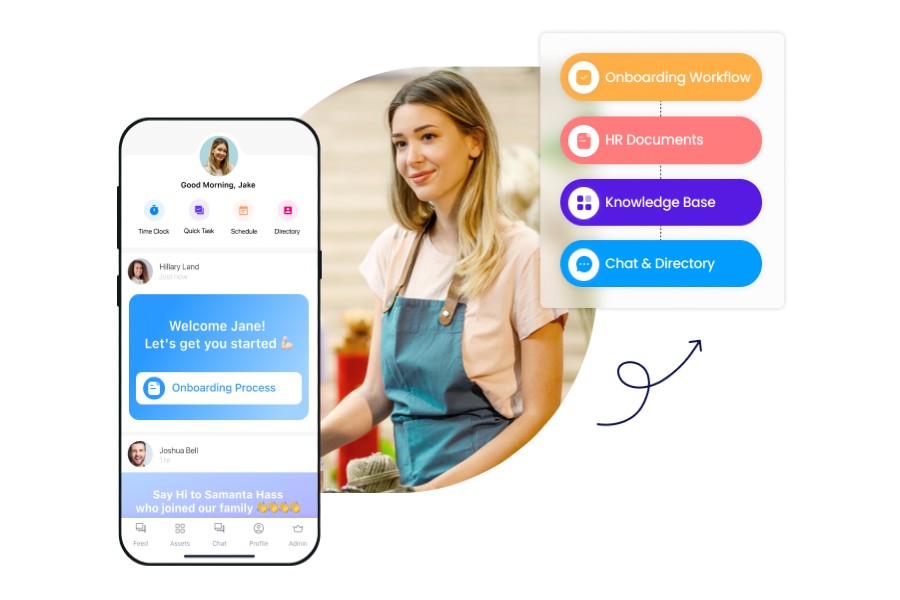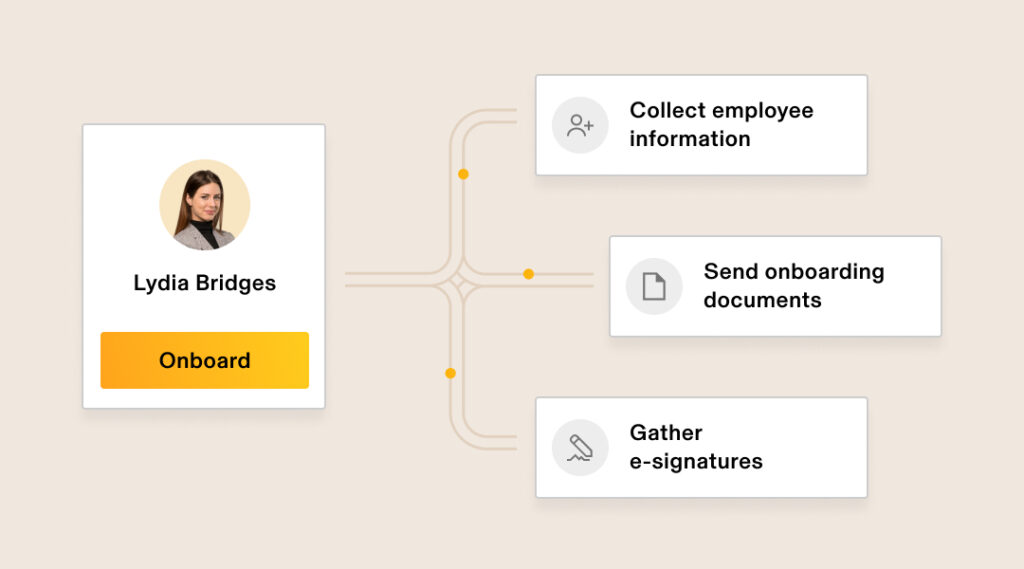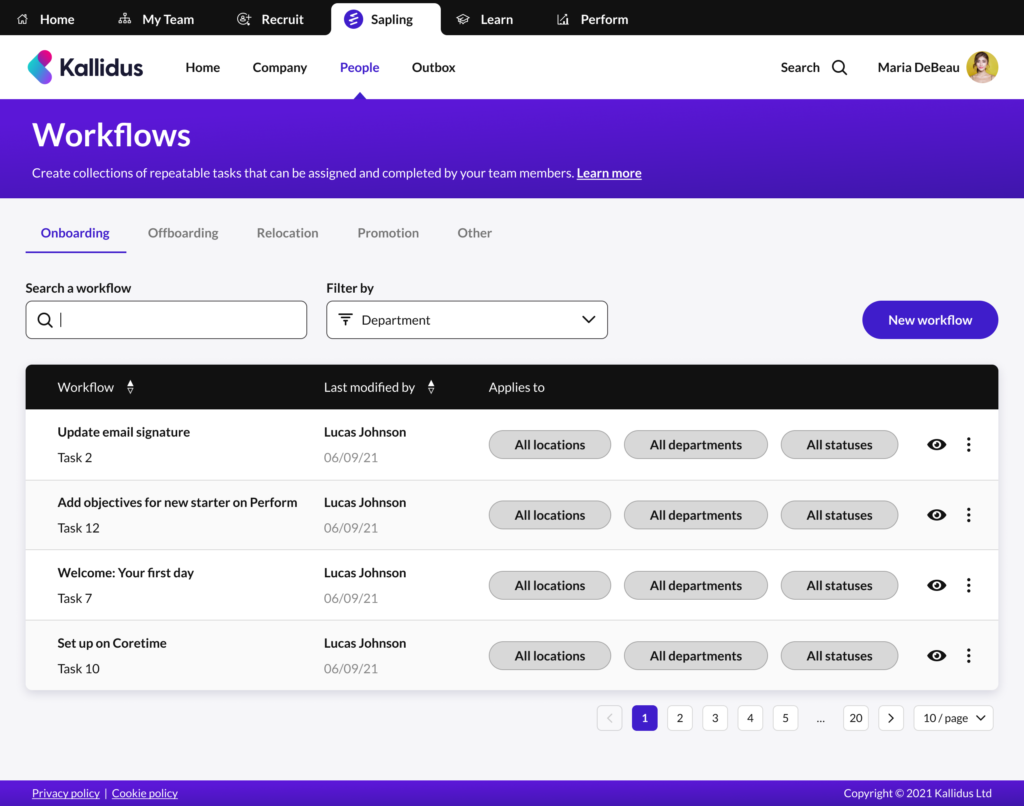The importance of giving a warm welcome to new hire in a new employee onboarding process cannot be denied. With the mobile industry at its peak, there is no doubt that an onboarding app can make the process more efficient.
A well-designed app helps in making the onboarding process digital. It strengthens the relationship of employees with their employers. The app can be the first point of contact for new hires and create an instant connection.
If you want to know more about employee mobile onboarding apps, then you have come to the right place. In this article, we have discussed in detail what it is, its importance, its approaches, how to choose the right app and some examples.
What is an employee onboarding mobile app
An employee onboarding app allows organizations to strategically communicate with new hires and help create a positive experience. It can educate new hires about the company, collect their information, and more
The app is a series of screens that helps users navigate through the app’s interface. It is an efficient method that enables the new employee to comprehend the functions of the onboarding process.
Who needs an onboarding app
According to Forbes, there are some business types and functions that need a mobile app to be competitive. These include event venues, eCommerce, financial services, field service management, customer service, real estate, staffing and recruiting, every customer-facing business, and more.
Organizations should first analyze whether the use of mobile onboarding apps can make their process stand out or not. They must also identify the type of employees, for whom the app will be most suitable. For instance, the app will be convenient for employees who do not have a personal computer. They can simply onboard at a time and place that suits them.
Choosing the right app
Organizations should get an app that is helpful for them in achieving the objective of onboarding. Here is what they should look for in an employee mobile onboarding app:
- Digitalizes paperwork: The mobile onboarding app should let organizations take care of all paperwork, contract, and e-signatures.
- Provides feedback: It must be able to collect and gather feedback to make necessary improvements.
- A communication portal: The app must have a specific chat portal that let new hires interact with other employees.
- Employee directory: A complete directory of the list of employees, with their basic information such as hierarchy, contact details, and titles.
- Creates Courses: A good app must let employers create courses for new hires. This helps in keeping employees engaged throughout the process.
- Database: The right app must allow employers to digitally store data that can be easily accessed by new hires.

Why use an employee onboarding app
We have apps for everything in this digital era. Organizations and businesses use apps to reach out to employees and customers. Similarly, the same idea of creating an app can be applied to the onboarding process which can deliver content directly to new hires digitally
Individuals nowadays are using smartphones for almost everything. Even though employee onboarding software helps in streamlining the entire process, these apps provide convenience to new hires by making the process more engaging, reliable, and fun.
Let us further look at the benefits which the onboarding app has:
Saves time and effort
An employee onboarding app can give them a tour of the office, introduce them to employees, collects onboarding documents, and help them get familiar with the company’s software without even stepping foot into the company’s premises. All of this helps in saving time, effort, and resources.
Higher retention
New hires must have applied to other companies as well. For that purpose, those recruiters might still be in contact with them. Therefore, onboarding through an app will engage, impress them, and secure their loyalty in the initial stage of their employment.
Learns culture, and roles quickly
There are a lot of things that a new hire needs to learn about the company. The employee onboarding app helps get familiar with the roles, responsibilities, and hierarchy more rapidly. The app makes learning and development more fun and enjoyable.
Feedback from employees
The employee onboarding app makes it easier to collect feedback from new hires. This anonymous feedback tells human resources what the employees are thinking and how can they improve their onboarding process.
Make your mobile onboarding app stand out
No doubt a mobile onboarding app helps organizations achieve the objective employee onboarding process. It also helps set a great first impression. Therefore, it’s essential to add such content to the app to make their transition easier. Following are some of the practical ways to make your mobile app onboarding process stand out.
Set an onboarding goal
When organizations create clear mobile onboarding app goals, it becomes easier for them to measure the success of their mobile onboarding process. It is highly crucial to keep the goals realistic and simple.
Optimize the steps
An expert mobile onboarding app will have a short number of steps that will motivate the new hires to complete the onboarding process. The steps must be concise, engaging, and must deliver the message.
Design an onboarding flow
Once the goals are determined, choose the right onboarding flow and type of mobile onboarding that is best for your new hires. The flow should be frictionless and consist of easy-to-accomplish tasks.
Use gamification
New hires can play games, have fun, and at the same time understand the company culture too. They can simply learn by doing it themselves.
Collect data and analyze outcome
Organizations must continue to update and improve their mobile onboarding process. The in-app analytics data regarding new hires’ behavior helps in optimizing the onboarding flow.

Mobile onboarding approaches
When an organization is creating a mobile onboarding application it must keep the new hire’s expectations and journey in mind. They should carefully format their mobile application. There are three popular approaches to mobile onboarding apps which are as follows:
Functional approach
The functional approach of the mobile onboarding app immediately shows new hires the core functions of onboarding. In short, it focuses on functionality and lets the user know how to operate the app.
This approach can also provide visual tours with detailed directions. The format is highly engaging for new hires and reduces the information to bite-sized chunks. Its design elements help convey the meaning.
Benefits-oriented approach
The focus of the benefits-oriented approach is on what can an app do rather than how to use it. This format is also known as feature-based onboarding. It showcases the benefits of the app.
This format aims to increase conversion. The value of the app is demonstrated before anything else in this approach. New hires can themselves opt out or in for allowing to receive notifications.
Progressive approach
The progressive approach allows the new hires to explore the mobile application by providing them access to information as they continue to navigate. The sole purpose of this approach is to enable new hires to learn by doing.
This type of app is great for intricating workflow, functionality, gesture-driven interaction, and more. This methodology is also very flexible for new hires as they can explore and learn at their speed.
Examples of mobile onboarding apps
Following are some of the companies that offer employee onboarding mobile apps:
Connecteams
Connecteams is considered as the best all in one employee on boarding app. It has many onboarding tools such as communication features, knowledge base, employee directory and more.
It allows to create quizzes after the completion of the section to ensure that the information is retained or not. With the help of their course features, they can make custom onboarding courses that are specific to new hires’ needs.

Rippling
Rippling is an employee onboarding platform that contains tools related to benefit enrolment and learning management. It further offers e-documents signed and stored electronically.
With the help of rippling features, employers can set up of devices, security, its monitoring. The human resource only needs to enter the information basic information of new hires and Rippling will do the rest.

Sapling
Many of the sapling features allow new hires to get connected with the members of the organization. They can simply look through the organization’s charts, know their position title, and contact them
When it comes to employee onboarding, it lets users create workflows automatically based on their location, employment type, and department. Their app allows them to fully digitize the systems with any third parties.

ClearCompany
It is most suitable for bulk onboarding. Its features allow employers to create bulk onboarding courses simultaneously. The app then is used to pre-schedule courses with check-in dates. It ensures that employees can communicate well with peers.
The advantage of this mobile-friendly employee onboarding app is that organizations can pay only for what they need. They can easily scale the growth of the company by using their performance management and onboarding feature

Comparison
Choosing the right app for your company can be very confusing. The following table provides a comparison of the above-mentioned apps:

In conclusion
To maintain long-term user retention and high engagement rates, mobile onboarding apps can be crucial. Organizations should research and think well before choosing the right onboarding type of app which they would offer their new hires.
An employer can get carried away with their creativity and would want to showcase all the cool things about the company. But at the same time, they need to keep it simple and not to overcomplicate things.
The purpose of the app should be to put users directly into the interface. The focus of the mobile app must be on understanding what new hires need in the app, what’s new, and how to keep instructional content engaging.


